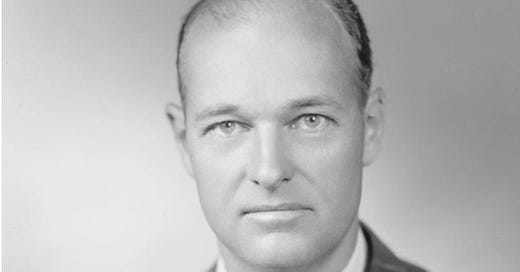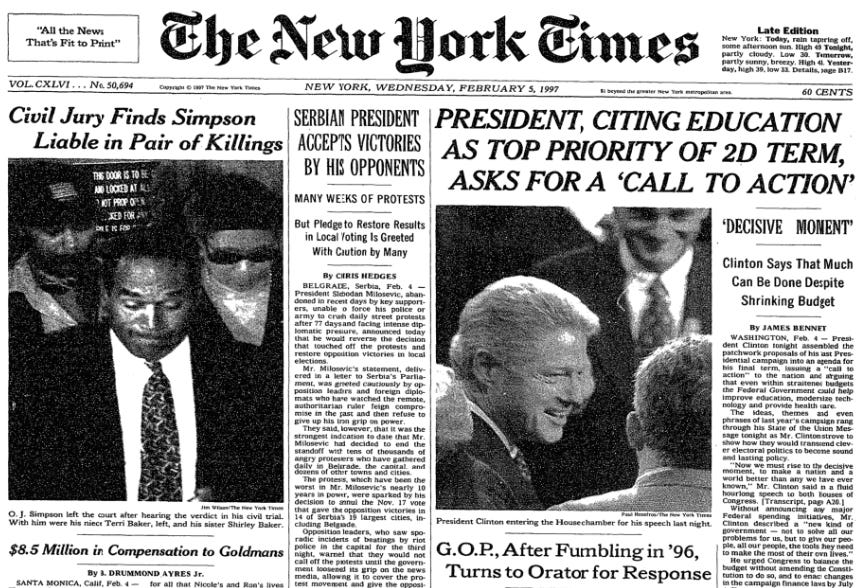An Old Cold Warrior’s Putin Prophecy
After the break-up of the USSR, an early Cold War Cassandra, warned of the lingering threat of a humiliated Russia. Should we have paid more attention?
On the morning of February 5, 1997, Washington woke in bleary confusion: Had the city just witnessed the strangest State of the Union in history?
The night before, President Bill Clinton had appeared before a joint session of Congress to deliver the annual address, 64 minutes of a robust, if not inspiring program for his newly won second term. But the president’s words had been overshadowed in real time by breaking news from California. The jury in the wrongful death civil suit against O.J. Simpson had reached its decision. On learning the news, the broadcast networks, aware of the public’s endless appetite for the Simpson saga, had elected to run a split screen, with the president delivering his speech on one side and the jury announcing its verdict – guilty – on the other.
The next morning, even the staid New York Times couldn’t resist splitting its front page – Simpson on the left, State of the Union on the right. The faces of O.J. and the president each took up two columns above the fold.
The spectacle of the news pile-up was so startling that few in the capital beyond foreign policy circles took much notice of a grim op-ed inside that same day’s paper. Titled “A Fateful Error” the article warned against the emerging consensus among American policy makers about plans to expand NATO. This consensus, endorsed by the Clinton administration, held that the triumphant western alliance, which had stared down the Soviet Union in the just-completed Cold War, should now expand to include former members of the Soviet-dominated Warsaw Pact. It was entirely possible that the western alliance could soon extend as far as Russia’s western borders.
In the eyes of the Op-Ed’s author, that was a terrible idea. Expanding NATO into Russia’s near abroad
may be expected to inflame the nationalistic, anti-Western and militaristic tendencies in Russian opinion; to have an adverse effect on the development of Russian democracy; to restore the atmosphere of the cold war to East-West relations, and to impel Russian foreign policy in directions decidedly not to our liking.
This was an unsettling, and surprising, set of claims. Five years after the break-up of the Soviet Union, few in the United States viewed Russia as a major ongoing threat to American security and the global order. Americans had long since grown accustomed to images consigning the Cold War to ancient history – the crowds flowing over the Berlin Wall, Mikhail Gorbachev winning the 1990 Nobel Peace prize, Bill Clinton throwing his arm over the shoulder of a grinning Boris Yeltsin.
Indeed, the very fact that former members of the Soviet-dominated Eastern Bloc were now eager to join the western alliance was mostly viewed as happy proof that the days of East-West tensions were well and truly done. The topic had merited only a single unremarkable paragraph in Clinton’s State of the Union address. “An expanded NATO is good for America,” the president had declared to bipartisan applause.
Even more surprising was the author of the ominous op-ed: George Kennan, the legendary Casandra of the Cold War. Half a century earlier, Kennan, a State Department official in Moscow, had authored the famed “Long Telegram” warning that cooperation with the Soviet Union was futile and that America’s central aim overseas must be arresting the spread of Soviet influence. This concept, which Kennan later crystalized as the “containment doctrine,” had been the guiding principle of US policy in its decades long struggle against the USSR.
Now, at age 92, Kennan had taken to the pages of the Times to issue another dire message about Russia. Throughout his career, Kennan had fixated on Russia’s profound sense of insecurity, a product of Russian history, its geographic position and its inflated sense of its own destiny. In the Soviet era, Russian leaders had paired this tendency with a deep paranoia about the west and the threat it posed to Soviet leadership’s control over its people.
As Kennan saw it, the Iron Curtain had now vanished but the dangers posed by Russia’s insecurity had not. In fact, it might well be exacerbated by the sense of abject humiliation that had pervaded the country since its Cold War defeat. Stretching NATO to Russia’s borders, Kennan felt, would needlessly feed Russian fears and risk propelling a paranoiac Russian leader to lasting and dangerous power.
That George Kennan would take issue with conventional wisdom on NATO expansion was not entirely shocking. For half a century, he’d toggled between the role of global seer and skunk at the garden party for the foreign policy set.
Still, the gravity of his current warning was striking. “Something of the highest importance is at stake here,” he warned in his Times piece. “Expanding NATO would be the most fateful error of American foreign policy in the entire post-Cold-War era.”
In the months since Vladimir Putin launched his invasion of Ukraine, I’ve thought a lot about the carefree optimism of the 1990s. I was 10 when the Soviet Union dissolved in 1991. Coming of age in the decade that followed, I was confident that the Cold War threat had been permanently vanquished. Russia was now our friend, or, at least, no longer our enemy. Indeed, the United States had no equal adversary, no country that would prove a looming existential threat.
The world grew smaller and its problems seemed small too. There was sober news from overseas, but it was usually squeezed further back in the evening newscasts, displaced by an endless parade of tabloid sensations– Lorena Bobbitt, Andrew Cunanan, the Clinton sex scandals. Our parents had to worry about nuclear annihilation. All we had to worry about was O.J.
We know now, of course, that there was plenty to worry about, complex questions about what the post-Cold War order should look like, questions that were inadequately addressed. Kennan’s warning in the Times now looks like one of several moments in the decade when reality could have broken through but didn’t. Here was the great prophet of the Cold War warning of an ongoing danger lurking in the Russian sphere. Shouldn’t we have paid a little more attention?
Behind closed doors in the Clinton White House, Kennan’s 1997 article did cause a stir. The day after it ran, Strobe Talbott, the Deputy Secretary of State, arrived in the Oval Office to find Kennan’s article sitting on Clinton’s desk. Clinton knew that Talbott, chief adviser on matters relating to the old Soviet Union, had considered Kennan an intellectual mentor for decades. Pointing to the article, Clinton asked the pointed query: “Why isn’t Kennan right?”
“It was common enough for Clinton to ask his advisers tough questions about his own policies,” Talbott would later write in his memoir, The Russia Hand. “But in this case, there was a hint of doubt about the policy itself – not the desirability of enlarging NATO but the feasibility of reconciling it with the integration of Russia. As the engineer in the locomotive, he was troubled by this latest forecast of a train from a revered figure with a reputation for being prophetic about Russia.”
Talbott assured his boss that history showed Kennan was wise but not infallible. Talbott recalled assuring Clinton that “the Russians were already making the transition from stomping their feet and emitting primal screams” over NATO expansion “to talking seriously with us about a solution.”
Clinton quietly pondered his adviser’s response for a while until a friendly smile filled his face. “Just checking, Strobe,” he said. “Just checking.”
By the end of Clinton’s term, NATO would expand to include Poland, Hungary and the Czech Republic and agree to a plan for further admissions that would make Russia’s borders the alliance’s eastern edge.
Has the course of history proven Kennan right?
On the specific question of NATO expansion, quite possibly not. After all, Putin’s Russia has menaced the west, invaded two of its neighbors and sought to make vassal states of several more. But, as yet, no Russian tanks have crossed the frontiers of a NATO member-state.
This is no small distinction. Had the alliance not expanded Article 5 protection to countries like Poland, Lithuania, Latvia and Estonia, the horrors of Mariupol and Bucha might well have been visited on Warsaw, Vilnius or Tallinn.
Indeed, exactly those sorts of horrors were at the top of mind for Eastern Europeans seeking NATO membership in the nineties. They had lived through the nightmares of the twentieth century and knew well which countries the roads from Moscow to Berlin ran through. Unlike their utopian western contemporaries, they had few illusions about what the twenty-first century might have in store. In her book, Not One Inch, Mary Elise Sarotte describes a 1997 conversation between Polish president Lech Walesa and Clinton. “Life does not like a vacuum,” Walesa told the American president, “and Russia really does not.”
Yet a careful study of Cold War history shows that while Kennan’s prescriptions for a foreign policy problem were sometimes wrong, his analysis of the underlying issue was always worthy of attention. His preoccupation in the nineties – how to deal with the ongoing problem of a humiliated Russia – was worthy of more serious consideration and public debate than it received.
That debate might have grappled with both the opportunities and the tradeoffs presented by NATO expansion. While pursuing the noble goal of providing protections for the formerly subject peoples of Eastern Europe, American policymakers might have been forced to grapple with hard questions. Among them: What was the proper role for America in Europe’s future security? Could the alliance expand toward Russia without causing a permanent rupture between Russia and the west? What would be the costs a larger NATO posed to US efforts to cooperate with the Russians on nuclear disarmament and global security? Assured of protections from an American-led NATO, would Europeans defer investment in their own security? What would it mean if a hostile leader, obsessed with Russian greatness, consumed by paranoia of the west, rose in the Kremlin once again?
Today, Putin alone is responsible for the horrors of his Ukraine invasion. But the confined space in which western leaders must now formulate their response to him is in part a consequence of failed American leadership in the nineties. Too often in that brief era of American invincibility, we failed to ask hard questions about what the post-Cold-War world would, and should, look like. Today, in the heart of Europe, the world is paying the price for that failure. What will be the next bill to come due?
Reading List
I highly recommend Mary Elise Sarotte’s Not One Inch: America, Russia, and the Making of Post-Cold War Stalemate. With unparalleled detail, and readable prose, Sarotte narrates the complex negotiations over the future of NATO in the 90s. At the conclusion of her book, Sarotte imagines scenarios in which the western alliance could have expanded its protective umbrella in Europe while also reaching a more stable structure for European security that included Russia.
This is First Rough Drafts, my free newsletter on how big events in history were covered at the time. Like this post? Feel free to share





